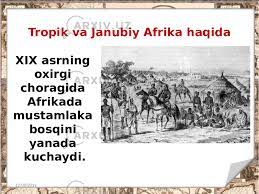SHARE WITH FRIENDS:
In 1918-1939 Tropical and South African countries
PLAN:
-
Political map of Africa after the First World War.
-
The struggle of African peoples for their rights.
Tropical Africa refers to the land area between the north and south of Africa. During the XNUMXth-XNUMXth centuries, this area was occupied by European countries. Dagomeia, Cameroon, Senegal, Mali, Rwanda, Somalia, Togo, Central African Republic, Guinea, Gabon, Chad, Congo, Niger, Mauritania, Madagascar and others were French colonies. Great Britain owned Ghana, Malawi, Nyasaland, Uganda, Sudan, Kenya, Nigeria, Sierra Leone, Gambia. Belgium owned the territory of present-day Zaire (it was called the Belgian Congo). Portugal occupied Angola, Mozambique, Guinea-Bissau. Italy took possession of Eritrea and part of Somalia, and Spain took possession of Equatorial Guinea and the Spanish Sahara.
South African countries include today's Republic of South Africa, Zimbabwe, Zambia, Namibia, Botswana, Lesotho, Swaziland. All of them were owned by Great Britain. There were only two officially independent states in Africa that were not conquered. These were the countries of Ethiopia and Liberia.
The struggle for the rights of the African people gave rise to the movement known as the Pan-African Movement. The initiator of this movement was lawyer G. Sylvester William. The 1st congress of the movement was convened in Paris in 1919. Representatives of 15 countries (including 9 African countries) took part in it. He had a project to create an African state.
During this period, the rise of the Pan-African movement was also caused by Garvism. American Negro Marcus Harvey in 1920 "Back to Africa!" came out with the slogan and declared himself the first emperor of Africa.
Three more Congresses were held before World War II. The ideas put forward by the Congress later had a certain positive significance in the growth of the national liberation movement.
In the 20s, the colonies became the raw material base of the developed countries. Each country gradually began to specialize. Tropical and South Africa provided 97% of the world's diamonds, 92% of cobalt, 40% of gold, and a third of platinum. Looting rampant. Assimilation was intensified in the colonies. The situation of the indigenous population worsened. Apartheid and segregation were rampant.
During the world economic crisis of 1929-1933, the situation of the African people became even worse. In South Africa, there was a drought, and the population of the reservation began to die of hunger and disease.
During World War II, there were hostilities in Ethiopia, Italian Somalia and Eritrea. In 1941, these lands were captured by British troops.
Hitler's Germany relied on the fascist organizations in South Africa, the Boer nationalists and the tens of thousands of Germans living there. The fascist organization "Yellow Shirts" operating in the country was managed directly from Berlin.
Thus, South and Tropical Africa was still dependent on the European countries, and the difficult path of the national-liberation movement lay ahead.
Control questions.
-
Which country started the war?
-
When did France surrender to Germany?
-
Why didn't Germany beat Great Britain?
-
When and how was the 2nd front opened in Europe?
-
Compare the surrender of Germany and Europe.
-
2 - what are the main results of the world war?
Basic expressions.
1. Operation "Sea Lion", 1940 German operation against Great Britain in year VIII.
-
"Triple Alliance" is an agreement concluded on September 1940, 27 between Germany, Japan and Italy.
-
The United Nations Organization was founded on October 1945, 24.
Test questions.
-
Which countries participated in Crimea, Tehran and Yalta conference?
-
A) Germany, Italy. B) USSR, Great Britain, USA.
-
C) USSR, USA, Germany.
-
When did the war end in Europe?
-
A) May 1945, 9. B) September 1945, 2. S) September 1946, 2.
